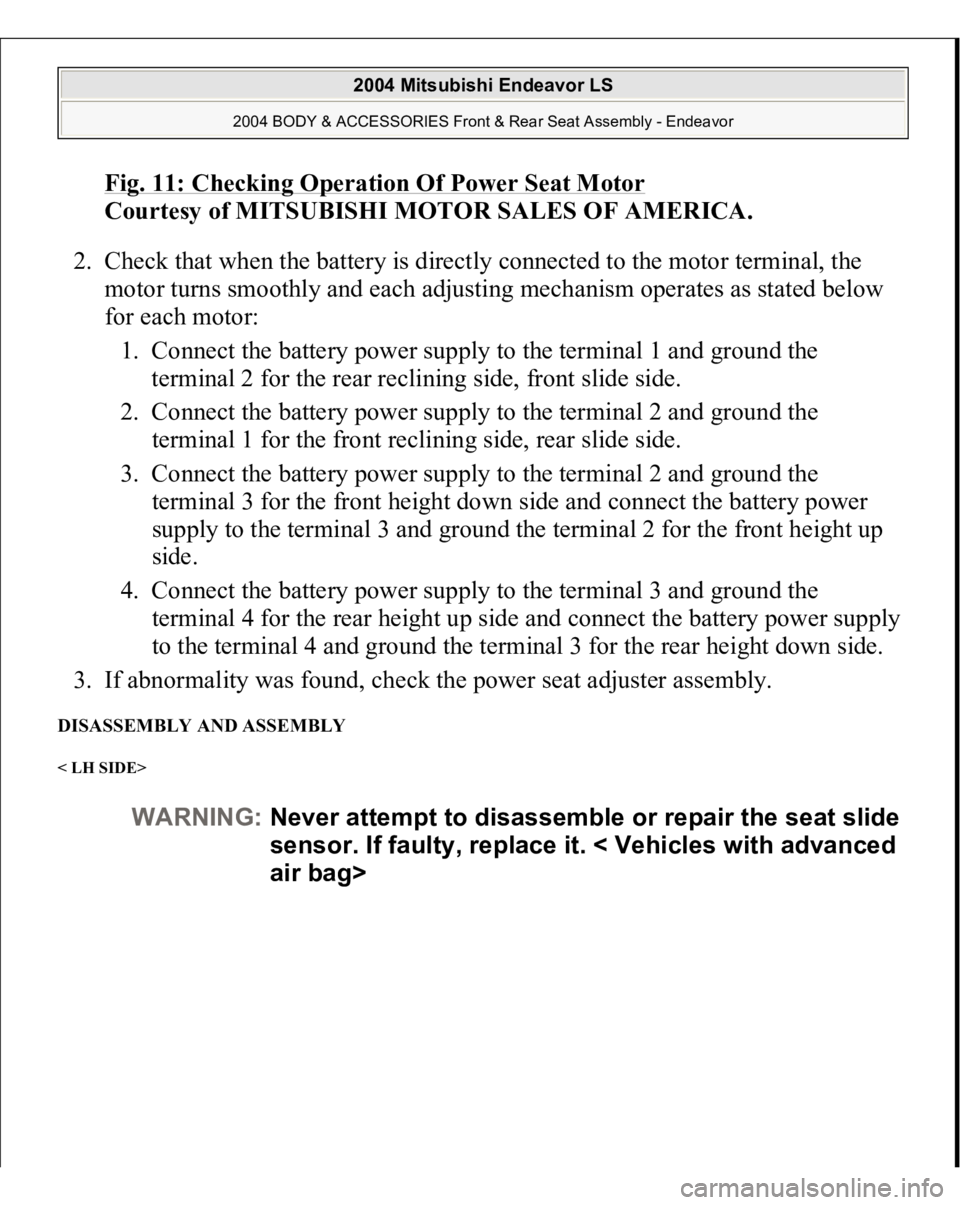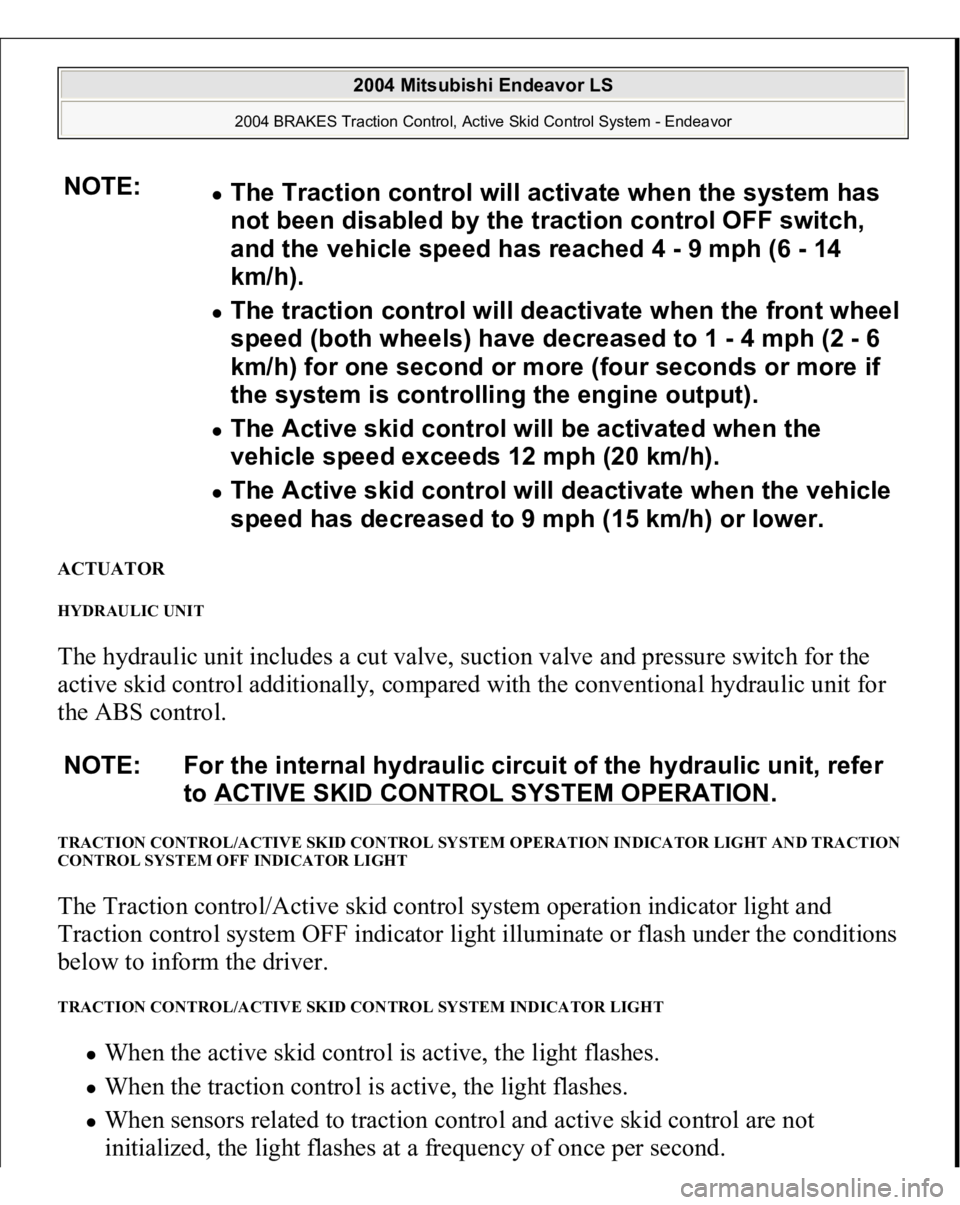Page 3081 of 3870
Fig. 39: Removing & Installing Rear Suspension Crossmember (AWD)
Courtesy of MITSUBISHI MOTOR SALES OF AMERICA.
REMOVAL SERVICE POINTS << A>> REAR ABS SENSOR REMOVAL < VEHICLES WITH ABS>
CAUTION: For vehicles with ABS, be careful when handling the
pole piece at the tip of the ABS sensor so as not to
damage it by striking against other parts.
2004 Mitsubishi Endeavor LS 2004 SUSPENSION Rear - Endeavor
Page 3082 of 3870
The rear ABS sensor can be damaged during service work. Unclamp the rear ABS
sensor cable as shown, and tie it out of the way.
Fig. 40: Removing Rear ABS Sensor
Courtesy of MITSUBISHI MOTOR SALES OF AMERICA.
<< B>> SHOCK ABSORBER ASSEMBLY/TRAILING ARM ASSEMBLY AND KNUCKLE CONNECTION < TEMPORARY
ASSEMBLING> After removing the driveshaft, assemble the knuckle and shock absorber assembly
and the trailin
g arm assembl
y tem
poraril
y to su
pport the knuckle.
2004 Mitsubishi Endeavor LS 2004 SUSPENSION Rear - Endeavor
Page 3088 of 3870
2004 BODY & ACCESSORIES
Front & Rear Seat Assembly - Endeavor
FRONT SEAT ASSEMBLY REMOVAL AND INSTALLATION Post-installation Operation
Adjustment Procedures of Special Function (refer to AIR BAG RESTRAINT SYSTEMS
.
WARNING:
Before removing the front seat assembly, refer
to SERVICE PRECAUTIONS and AIR BAG RESTRAINT SYSTEMS
.
When removing and installing the front
passenger seat, be sure to carry out accuracy
check occupant classification sensor after the
seat has been installed in the vehicle. (Refer to
AIR BAG RESTRAINT SYSTEMS
.
2004 Mitsubishi Endeavor LS
2004 BODY & ACCESSORIES Front & Rear Seat Assembly - Endeavor
2004 Mitsubishi Endeavor LS
2004 BODY & ACCESSORIES Front & Rear Seat Assembly - Endeavor
Page 3099 of 3870

Fig. 11: Checking Operation Of Power Seat Motor
Courtesy of MITSUBISHI MOTOR SALES OF AMERICA.
2. Check that when the battery is directly connected to the motor terminal, the
motor turns smoothly and each adjusting mechanism operates as stated below
for each motor:
1. Connect the battery power supply to the terminal 1 and ground the
terminal 2 for the rear reclining side, front slide side.
2. Connect the battery power supply to the terminal 2 and ground the
terminal 1 for the front reclining side, rear slide side.
3. Connect the battery power supply to the terminal 2 and ground the
terminal 3 for the front height down side and connect the battery power
supply to the terminal 3 and ground the terminal 2 for the front height up
side.
4. Connect the battery power supply to the terminal 3 and ground the
terminal 4 for the rear height up side and connect the battery power supply
to the terminal 4 and ground the terminal 3 for the rear height down side.
3. If abnormality was found, check the power seat adjuster assembly.
DISASSEMBLY AND ASSEMBLY < LH SIDE>
WARNING:Never attempt to disassemble or repair the seat slide
sensor. If faulty, replace it. < Vehicles with advanced
air bag>
2004 Mitsubishi Endeavor LS
2004 BODY & ACCESSORIES Front & Rear Seat Assembly - Endeavor
Page 3101 of 3870
WARNING:< Vehicles with advanced air bag>
Never attempt to disassemble or repair the
occupant classification-ECT or the occupant
classification sensor. If faulty, replace it. Do not drop or subject the occupant
classification-ECU and occupant classification
sensor to impact or vibration. If denting,
cracking, deformation, or rust are discovered in
the occupant classification-ECU or the occupant
classification sensor, replace it with a new
occupant classification-ECU or the occupant
classification sensor.
2004 Mitsubishi Endeavor LS
2004 BODY & ACCESSORIES Front & Rear Seat Assembly - Endeavor
Page 3112 of 3870
A whining sound is caused by the TCL/ASC hydraulic unit motor. When pressure is applied to the brake pedal, the pulsation of the pedal causes a
scraping sound. When the brakes are applied firmly, the TCL/ASC operates, rapidly applying
and releasing the brakes many times per second. This repeated application and
release of braking forces can cause the suspension to make a thumping sound
and the tires to squeak.
SENSOR G AND YAW RATE SENSOR This sensor is mounted under the center console, and detects lateral acceleration,
longitudinal acceleration and steering angular velocity of the vehicle.
Fig. 3: Identifying G And Yaw Rate Sensor
2004 Mitsubishi Endeavor LS
2004 BRAKES Traction Control, Active Skid Control System - Endeavor
Page 3113 of 3870
Courtesy of MITSUBISHI MOTOR SALES OF AMERICA
.
STEERING WHEEL SENSOR
This sensor is mounted behind the column switch, and detects the steering
wheel position. The steering wheel sensor has a self-diagnosis function and a memory
function. If the diagnosis function finds a trouble, it sends a DTC code to the
TCL/ASC-ECU. Then the ECU will illuminate the TCL/ASC indicator light.
Fig. 4: Identifying Steering Wheel Sensor
Courtesy of MITSUBISHI MOTOR SALES OF AMERICA.
TRACTION CONTROL OFF SWITCH
NOTE: For the details of the DTC codes, refer to DIAGNOSTIC
TROUBLE CODE CHART
.
2004 Mitsubishi Endeavor LS
2004 BRAKES Traction Control, Active Skid Control System - Endeavor
Page 3115 of 3870

ACTUATOR HYDRAULIC UNIT The hydraulic unit includes a cut valve, suction valve and pressure switch for the
active skid control additionally, compared with the conventional hydraulic unit for
the ABS control. TRACTION CONTROL/ACTIVE SKID CONTROL SYSTEM OPERATION INDICATOR LIGHT AND TRACTION
CONTROL SYSTEM OFF INDICATOR LIGHT The Traction control/Active skid control system operation indicator light and
Traction control system OFF indicator light illuminate or flash under the conditions
below to inform the driver. TRACTION CONTROL/ACTIVE SKID CONTROL SYSTEM INDICATOR LIGHT
When the active skid control is active, the light flashes. When the traction control is active, the light flashes. When sensors related to traction control and active skid control are not
initialized, the li
ght flashes at a fre
quenc
y of once
per second.
NOTE:
The Traction control will activate when the system has
not been disabled by the traction control OFF switch,
and the vehicle speed has reached 4 - 9 mph (6 - 14
km/h). The traction control will deactivate when the front wheel
speed (both wheels) have decreased to 1 - 4 mph (2 - 6
km/h) for one second or more (four seconds or more if
the system is controlling the engine output). The Active skid control will be activated when the
vehicle speed exceeds 12 mph (20 km/h). The Active skid control will deactivate when the vehicle
speed has decreased to 9 mph (15 km/h) or lower.
NOTE: For the internal hydraulic circuit of the hydraulic unit, refer
to ACTIVE SKID CONTROL SYSTEM OPERATION
.
2004 Mitsubishi Endeavor LS
2004 BRAKES Traction Control, Active Skid Control System - Endeavor